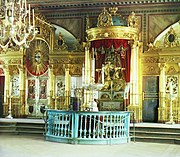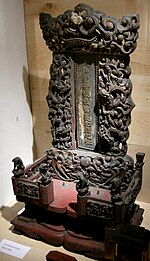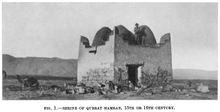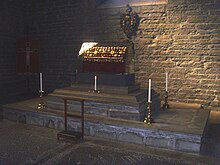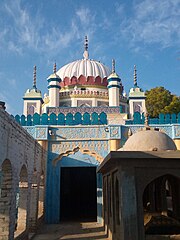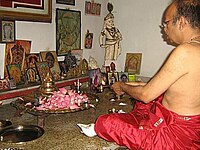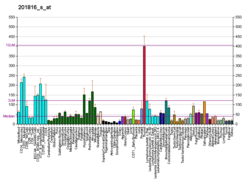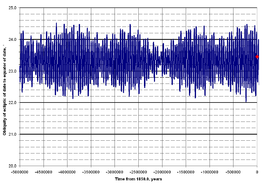사당
Shrine사당(라틴어: Scrinium "책이나 종이를 담는 상자 또는 상자")[1]은 특정한 신, 조상, 영웅, 순교자, 성자, 데몬 또는 유사한 존경의 인물에게 바치는 신성한 공간이다.사당에는 종종 [2]우상, 유물 또는 숭배받는 인물과 관련된 다른 물건들이 있다.봉납물을 올리는 사당은 제단이라고 불린다.
사당은 기독교, 이슬람, 힌두교, 불교, 중국 민속 종교, 신도, 필리핀 원주민 민속 종교, 아사트루 등 세계 여러 종교에서 볼 수 있으며 전쟁 기념과 같은 세속적이고 비종교적인 환경에서도 볼 수 있다.신사는 교회, 사찰, 묘지, 박물관, 가정 등 다양한 환경에서 볼 수 있다.그러나 휴대할 수 있는 신사는 [3]문화권에서도 볼 수 있다.
신사의 종류
사당
많은 성지들이 건물 안과 기독교의 교회나 힌두교의 만디르처럼 예배를 위해 특별히 설계된 사원 안에 위치해 있다.이곳의 사당은 보통 건물의 관심의 중심이며 눈에 띄는 장소가 주어진다.이러한 경우, 신자들은 신사에서 신을 숭배하기 위해 건물 안에 모인다.고전적인 사원 건축에서, 신사는 [citation needed]셀라와 동의어일 수 있다.
사당
역사적으로 힌두교, 불교, 로마 가톨릭, 그리고 네오파간교와 같은 현대 신앙에서, 사당은 일반적으로 가정이나 [4]가게 안에서 발견될 수 있다.이 사당은 보통 공식 종교의 일부인 신, 조상 또는 지역화된 [5]가신에게 바치는 작은 건물이나 그림이나 조각상의 설치물이다.
야드 신사
발리 힌두교, 기독교 등 다양한 종교를 따라 많은 사람들의 정원의 바닥에는 작은 야외 마당이 있다.많은 것들이 예수상, 성모 마리아상, 받침대 위 또는 도코브에 있는 성모상으로 구성되어 있고, 다른 것들은 천장이 없는 정교한 부스일 수도 있고, 그림, 조각상, 그리고 벽, 지붕, 유리문, 철제 [citation needed]울타리와 같은 건축 요소들을 포함하고 있다.
미국에서, 일부 기독교인들은 작은 마당을 가지고 있다; 그들 중 일부는 틈새나 동굴에 놓여진 조각상으로 구성되어 있기 때문에 측면 제단과 유사하다; 이러한 유형은 구어체로 욕조 [6]마돈나라고 불린다.
길가의 신사
종교적 이미지는 보통 작은 대피소 같은 곳에 있으며, 길이나 길가에 놓여 있으며, 때로는 정착지나 [citation needed]교차로에 놓여 있다.
종교 사당
신사는 많은 종교에서 볼 수 있다.사찰과 구별되는 사당은 보통 숭배나 숭배의 대상인 특정한 유물이나 숭배 이미지를 보관한다.참배자의 편의를 위해서가 아니라 특히 신성하다고 생각되는 장소를 구분하기 위해서도 사당이 건설될 수 있다.그래서 사당은 순례의 [7][8]관행을 끌어당긴다.
기독교
신사는 기독교의 전부는 아니지만 많은 형태로 발견된다.기독교의 [9]가장 큰 종파인 로마 가톨릭은 정교회, 성공회, 그리고 루터교의 일부 형태처럼 많은 성지가 있다.
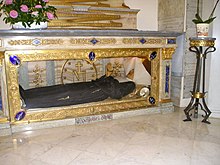
로마 가톨릭 1983년 교회법 강령 1230년과 1231년: "성당이라는 용어는 지역 평의원의 승인을 받아 순례자로서 신도들이 자주 방문하는 특별한 헌신 때문에 교회 또는 다른 신성한 장소를 의미합니다.성지가 국가적으로 묘사되려면 주교회의의 승인이 필요하다.그것이 국제적인 것으로 묘사되려면 교황청의 승인이 필요하다.[10]
구어체 카톨릭 용어로 "신사"라는 용어의 또 다른 사용법은 교구민들이 교회에서 개인적으로 기도할 때 사용하는 대부분의, 특히 더 큰 교회에서 틈새 또는 도코브입니다.그것들은 작은 측면 제단이나 바이알타처럼 보일 수 있기 때문에 예배 제단이라고도 불렸다.성지들은 항상 그리스도, 마리아 또는 성인의 이미지들에 집중되어 있었고, 예를 들어,[citation needed] 조각상, 그림, 벽화, 모자이크 등, 그들 뒤에 레레도들이 있었을지도 모른다.
하지만, 미사는 그들에게서 기념되지 않을 것이다; 그들은 단지 기도에 도움을 주거나 시각적인 초점을 주는 데 사용되었다.미사가 실제로 거행될 수 있는 측면 제단은 교구민들에 의해 성지와 비슷한 방식으로 사용되었습니다.측면 제단은 특별히 성모 마리아, 성 요셉 그리고 다른 성인들에게 [citation needed]바쳐졌다.
성당의 정의는 성스러운 장소나 신성한 [citation needed]장소이기 때문에 예수탄생 세트는 또한 성지로 여겨질 수 있다.
이슬람
이슬람의 가장 신성한 건축물인 메카에 있는 카바(알 하람 모스크 내)는 비록 고대 사원이지만, 하자르 알-아스와드라고 불리는 존경받는 유물을 수용하고 있고 또한 세계 최대의 순례 수행의 일부인 하지 때문에 성지로[11][12][13] 보일 수 있다.몇 야드 떨어진 모스크에는 이슬람 [14][15]전통에 따라 총대주교와 그의 아들 이스마엘의 카바 건물과 관련된 페트로소마토글리프가 있는 마캄 이브라힘('아브라함의 역') 사원이 있다.이슬람 예언자 무함마드의 그린돔 묘지(그의 묘실에는 그의 친구 아부 바크르와 가까운 동반자 우마르의 무덤도 있다)[16][17][18]는 마스지드 안-나바위에 있으며 이슬람교도들 사이에서 크게 존경받는 장소이자 순례지로 중요한 곳이다.
수니파 이슬람
가장 오래되고 주목할 만한 이슬람 성지 중 두 곳은 바위의 돔과 예루살렘의 [19]템플 마운트에 세워진 쇠사슬의 돔이다.전자는 유대교 신전이 있던 곳을 표시한 바위 위에 세워졌으며 이슬람 전통에 따르면 무함마드의 전설적 천국 등정의 출발점이었다.[20][21]
이슬람 세계의 다른 어떤 성지보다,[22] 무함마드의 무덤은 방문객들에게 축복의 원천으로 여겨진다.무함마드의 것으로 여겨지는 말 중에는 "내 무덤을 방문하는 자는 [22][23][24]내 중재에 대한 권리를 갖게 될 것이다."라는 말이 있다.성지순례 후 무함마드의 무덤을 방문하는 것은 수니파 법률학자들의 대다수가 [25]추천할 만한 것으로 보고 있다.
살라프의 초기 학자인 아흐마드 이븐 한발 (241 AH), 이샤크 이븐 라와이 (238 SH), 압둘라 이븐 무바라크 (189 AH), 이맘 샤피이 (204 AH)는 모두 예언자의 [26]무덤에서 지야라의 수행을 허락했다.하디스 학자인 카디 아이야드 (d. 554 AH)는 예언자를 방문하는 것은 "이슬람교도들의 순나이며, 선하고 바람직한 행동"[27]이라고 말했다.
Ibn Hajar al-Asqalani (852 AH)는 예언자의 무덤을 방문하기 위해 여행하는 것은 "신에게 다가가는 최고의 행동 중 하나이자 가장 고귀한 행위이며, 그 합법성은 [28]합의의 문제"라고 분명히 말했다.마찬가지로, 이븐 쿠다마(d. 620 AH)는 예언자의 지야라를 추천하고 [29][30]무덤에서 예언자에게 직접 중재할 것을 요구했다.
다른 이슬람 종교계 인사들의 무덤도 존중된다.수니파의 주요 법학자 중 한 명인 아흐마드 이븐 한발의 아들은 [31]아버지보다 성인의 무덤 근처에 안장되는 것이 낫다고 말한 것으로 알려졌다.이슬람 세계의 일부 지역에서는 무덤이 단순히 종교인의 무덤의 지야라의 장소로 보여지는 반면, 다른 지역에서는 제대로 된 성지로 취급된다.[32][33][34]
살라피와 와하비 집단의 무덤 사원에 대한 반대
많은 현대 이슬람 개혁가들은 무덤 사원을 짓는 것을 [35]진정한 이슬람에서 벗어난 것으로 보고 반대한다.여기에는 주로 와하비와 살라피 운동의 추종자들이 포함되는데, 이들은 묘지 위의 성지가 우상숭배/다신교(shirk)를 조장하고 신(죽은 [36][37][38][39]자) 이외의 예배를 드릴 위험이 있다고 믿는다.
와하비 운동의 창시자인 무함마드 이븐 압드 알 와하브는 예언자 무함마드의 무덤에 이슬람 사원을 짓는 것을 금지했는데, 그는 "신이 그들의 예언자들의 무덤을 예배 장소로 만드는 유대인과 기독교인들을 저주하시기를 바랍니다.[40] 그들을 모방하지 마세요."라고 말했다.게다가 그는 학자 이맘 알 샤피가 지지했던 [39]무덤을 고르는 일(타스위야트 알 쿠부르)을 지휘했다.
와하비 운동은 중세 한발리 신학자 이븐 타이미야(Ibn Taymiyyah)의 저작에 큰 영향을 받았으며, 그는 "많은 문제에 대한 궁극적인 권위자"[41]로 간주되었다.이 이슈들 중 하나는 예언자의 무덤 방문에 대한 입장이었다.이븐 타이미야(Ibn Taymiyyah)에 따르면 예언자의 무덤 참배를 권장하는 모든 아하디스는 조작된 것이며, 하디스나 무스나드 아흐마드 이븐 한발의 6대 컬렉션에 포함되지 않으며, 타와이드 알-울루히야를 [42]위반한다.
이븐 타이미야에 대한 이러한 견해는 그의 생전 및 사후 수니파 주류 학자들에 의해 거부되었다.샤피 하디스의 거장 이븐 하자르 알-아스칼라니(Ibn Hadith)[43]는 "이븐 타이미야(Ibn Taymiya)에 대해 보고된 것 중 가장 추악한 위치"라고 말했다.그 하나피 hadith 학자 알리 al-Qari,"그 Hanbalis 중, 이븐 Taymiyya을 극단으로 그는 선지자 –을 방문할 여행을 금지하도록 하여 하나님과 그에게 보석을 그를 평화 복 갔다"[44]Qastallani은 "샤이흐 Taqi 알딘 이븐 Taymiyya이톤을 방문할 여행이 효과 이 문제에 관하고 이상한 지긋지긋한 진술했다고 밝혔다 진술했다그 예언자는 금지되어 있으며 경건한 [45]행위가 아니다."
시아파
시아파에는 역사적으로 중요한 다양한 종교인들을 위한 마자르가 몇 개 있고, 특히 이라크(카르발라,[46] 나자프,[47][48] 사마라[49] 등)와 이란(콤[50], 마샤드[51] 등)에 시아파 종교인들을 위한 정교한 성지가 몇 개 있다.
시아파 사원의 구체적인 예로는 알-아스카리 [52]사원과 이맘 후세인 [53]사원이 있다.다른 시아파 성지들은 아프가니스탄의 [54]마자르-에 샤리프와 이란의 [55]마슈하드 (알리다의 성지)에 위치해 있다.테헤란의 루홀라 호메이니 묘소에는 1978-79년 이란 혁명의 지도자 루홀라 호메네이와 그의 아내, 그리고 몇몇 다른 관련자들의 [56][57][58]무덤이 있다.
수피
대중적인 수피즘에서, 한 가지 일반적인 관습은 성인, 유명한 학자, 그리고 의인들의 무덤을 방문하거나 순례하는 것입니다.이것은 유명한 무덤인 타지키스탄 쿨롭의 Sayyid Ali Hamadani, 중국 Kashgar 근처의 Apaq Khoja, 신드의 Lal Shahbaz Qalandar, 파키스탄의 Lahorya의 Ali Hujwiri와 같은 성인들의 무덤이 있는 인도 대륙에서 특히 흔한 관습이다.안녕, 인도, 그리고 방글라데시 [59]실렛의 샤 잘랄.마찬가지로 모로코 페즈에서도 경건한 방문지로 유명한 곳은 Zaouia Moulay Idriss [60]2세입니다.말리의 팀북투 주변 지역에도 최근 이슬람교도들에 의해 파괴된 역사적인 수피 사당이 많다.이 중 많은 것들이 그 이후로 [61][62][63]재건되었다.성인의 무덤은 축복이나 바라카가 죽은 성인에게 계속 전달되는 큰 존경의 장소이며, 수피 신앙에 따라 방문하는 신도들과 순례자들에게 혜택을 주는 것으로 (일부 사람들에 의해) 여겨진다.왕이나 귀족들은 수피족에게 경의를 표하기 위해 무덤을 보존하고 건축적으로 [64][65]개조하기 위해 거액의 기부금이나 액수를 제공했습니다.시간이 흐르면서, 이러한 기부, 의식, 연례 기념식은 받아들여진 규범들의 정교한 시스템으로 형성되었다.이러한 형태의 수피 수행은 정해진 날짜 [66]즈음에 정신적, 종교적 전통의 분위기를 만들어냈다.많은 정통파나 이슬람 순수주의자들은 특히 존경받는 [67]성인들로부터 축복을 받기를 바라는 이러한 방문의 무덤 의식을 비난한다.
바하이 페이스
가장 잘 알려진 두 개의 바하이 신앙 사원은 바하이 신앙의 중심 인물인 바브와 바하울라의 유골 각각을 위한 안식처 역할을 한다.바하이 순례의 초점입니다.
다른 유적지는 캐나다 [70]퀘벡 주 몬트리올에 있는 윌리엄 서덜랜드 맥스웰과 메이 맥스웰의 고향인 바하이 신사로 지정되었다.
불교


불교에서 사당은 부처님이나 보살 중 한 분을 공경하는 장소를 말합니다.승려, 수녀, 평신도 모두 이러한 신사에서 이 존경받는 인물들에게 제물을 바치고 그들 앞에서 명상한다.
일반적으로, 불교 사원은 다양한 [71]보살들 중 하나인 부처상 또는 (불교의 대승과 대승의 형태)을 포함하고 있다.그것들은 또한 꽃, 정제수, 음식, 향과 같은 제물과 함께 일반적으로 촛불을 포함합니다.많은 성지에는 또한 스리랑카의 한 성지에 보관된 부처의 이빨과 같은 신성한 유물이 있다.
불교에서 특히 죽은 부처와 존경받는 승려들의 유물이 있는 장소별 사당은 종종 스탑으로 알려진 전통적인 형태로 설계된다.
필리핀의 민속 종교
필리핀의 토착 민속 종교를 계속 고수하는 고대 필리핀인과 필리핀인들은 일반적으로 외국 [72][73][74]문화에 알려진 맥락에서 소위 "예배본"을 가지고 있지 않다.하지만 그들은 영가라고도 불리는 신성한 [72]신사를 가지고 있다.작은 지붕이 있는 플랫폼부터 작은 집과 비슷한 구조물(벽이 없지만), 탑과 비슷하게 생긴 사당, 특히 초기 모스크가 같은 [75]방식으로 만들어졌던 남쪽의 사당까지 크기가 다양합니다.이들 신사는 민족협회에 [note 1]따라 다양한 토착어로 알려져 있다.그것들은 또한 조상들의 타오타오와 관을 보관하는 장소로 사용될 수 있다.비콜라노 중에서 타오타오는 또한 [72][76][77][78]무그라고 불리는 신성한 동굴 안에 보관되었다.
특정한 의식 동안, 아니토는 신성한 장소 근처의 임시 제단을 통해 숭배된다.비사얀에서는 라탕간 또는 란타얀, 타갈로그에서는 [note 2]담바나 또는 람바나라고 불렸습니다.이 대나무 또는 등나무 제단은 필리핀의 대부분 지역에서 기본적인 건축이 동일하다.지붕이 없는 작은 플랫폼이거나 끝이 갈라진 기둥(티키 횃불과 유사)이었다.그들은 반토막 난 코코넛 껍질, 금속 접시, 또는 마타반 항아리를 제물로 바치는 용기로 사용했다.이러한 플랫폼에는 [72][76]타오타오가 배치되는 경우도 있습니다.
다른 형태의 성지 또는 디와타 숭배 대상은 그들의 영역의 물질적 표현을 포함한다.가장 널리 존경받는 것은 발레트 나무와 개미 또는 흰개미 언덕이었다.다른 예로는 산, 폭포, 숲, 암초, [72][73][79][80][81]동굴 등이 있다.
게르만 이교
게르만 이교에서는 성지의 종류가 사용되었지만, 성지에 대한 용어는 어느 정도 모호함을 보여줍니다.
- Hörgrs는 원래 "성지"만을 지칭했을 수도 있지만, 고대 영어 동족상인 Hörgrs는 "성지" 및/또는 "템플, 아이돌"[82]을 의미할 수도 있습니다.
- 베스(고대 노르드어) 또는 워스(고대 영어)로, 사당 또는 신성한 울타리의 한 종류를 나타냅니다.이 용어는 스칸디나비아(아이슬란드 제외)의 스칼드 시와 지명에서 등장하며, 종종 노르웨이의 신이나 지리적 특징과 관련이 있다.북유럽의 신 베의 이름은 [83]관행을 가리킨다.
힌두교
힌두교에서 사당은 신이나 여신을 숭배하는 장소이다.사당은 전형적으로 다양한 형태의 힌두 사원 안에 위치해 있다.대부분의 힌두교 가정에는 집안 사당도 있다.예를 들어, 스테판 호일러가 힌두교 가정집을 방문했을 때의 회고록에 따르면, 집의 일부가 가정 사당에 헌정되었다.이곳에서는 [84]절을 찾는 대신 신상을 올려놓고 기도를 드렸다.타밀 힌두교 가정 중, Pintchman에 따르면, 키친에 있는 사원이 더 흔하다.집안이 부유하면 별실에 [85]사당을 둘 수도 있다.
도교

도교에서 절과 사당 사이의 경계는 완전히 정의되어 있지 않다; 사당은 보통 더 큰 도교 사원의 작은 버전이나 가정 내의 음양의 상징이 명상과 도교의 본문 및 원칙에 대한 연구를 장려하기 위해 평화로운 환경 속에 놓여 있는 작은 장소이다.도교에서는 다른 아시아 종교에 비해 공식적인 참배를 덜 강조하지만 의식화된 예배를 포함한다; 공식적인 사원과 예배의 구조는 대부분 불교 [citation needed]신자를 잃는 것을 막기 위해 도교에서 생겨났다.
도교 사원의 빈번한 특징은 완전한 사찰과 같은 특징을 가지고 있으며, 종종 다음과 같은 특징을 포함한다: 정원, 수돗물 또는 분수, 작은 불붙은 화로 또는 촛불(향의 유무), 그리고 노자, 장자 또는 다른 도가의 서적과 같은 도교 서적의 사본.es.[citation needed]
유교
많은 유교 사찰과 사당이 중국 전 세계에 존재하며 공자, 위대한 현인, 저명한 유학자, 그리고 공자의 제자들을 위한 절이다.이 사찰들은 "공자의 사원" 또는 "문학의 사원"으로 알려져 있다.도교 사찰과 달리 유교 사찰은 공자의 상을 설치하는 것이 아니라 위패를 설치하는 것이 일반적입니다.이 절은 공자 자신이 아니라 공자의 가르침을 기리기 위한 것이라는 주장이 있다.사찰은 정원과 향을 피우는 큰 정자로 이루어져 있다.공자의 위패나 때로는 공자의 상이 주로 본당에 놓여 있다.
유교 사당은 주로 일본, 한국, 베트남 등 중국 밖에도 존재한다.대만에는 타이난 유교 사원, 타이베이 공자 사원 등 많은 유교 사원이 있어 정부가 잘 관리하고 있다.하지만, 많은 도교 사원들은 공자나 문학의 신인 원창디쥔을 모시는 사당을 모셨다.
세속적인 신사
세계 일부 국가에서는 랜드마크가 "역사적인 [citation needed]성지"라고 불릴 수 있다.이런 유형의 유명한 신사는 다음과 같습니다.
- 미국 텍사스 주 샌안토니오의 알라모.
- 미국 메릴랜드주 볼티모어에 있는 포트 맥헨리
- 미국 로드아일랜드 뉴포트의 투로 시나고그
- 호주 멜버른에 있는 전쟁 기념관인 추모 성지
- 호주 브리즈번에 있는 전쟁 기념관인 '기억의 성지'
- 러시아 모스크바에 있는 레닌의 무덤
- 금수산태양궁전
명예의 전당은 또한 지역, 문화 또는 분야에 대한 영향력을 바탕으로 한 명 또는 여러 명의 개인이 헌액되는 성지 역할을 한다.흉상이나 전신상은 종종 기념으로 세워지고 나란히 놓인다.여기에는 스포츠 선수들을 기리는 명예의 전당이 포함됩니다. 이 전당에 선수의 입장은 일반적으로 "감정"이라고 표현됩니다.
성지(聖地)[86]라는 용어는 콜로라도주 콜로라도 스프링스에 있는 태양의 신전처럼 특정 인물이나 대상에게 완전히 헌정되는 장소를 의미하게 되었다.
「 」를 참조해 주세요.
- 오스트레일리아 원주민의 성지
- 지구의 신비
- 이슬람 성지 (시아)
- 이슬람 성지 (수니)
- 필리핀 원주민의 성지 및 성지
- 신사 목록
- 누멘
- 임시방편/도로변 기념비
- 성스러운 자연 유적지
- 성역
- 성모 마리아 성지
- 신비의 신전 귀족들의 고대 아랍어 기사단
- 신사
메모들
- ^ 비사얀에서는 마그단탕, 타갈로그에서는 울랑고 또는 심바한으로 알려져 있습니다.이트네그 교파들 사이에서, 사당은 탕파프, 팡큐, 또는 알라롯 (각종 지붕이 있는 작은 제단용)과 발라우아 또는 칼랑간 (더 큰 구조물용)으로 알려져 있다.민다나오에서는 사당이 말리가이, 테두라이에서는 테닌, 바고보에서는 부이(도로와 마을 근처에 건설된 것)와 파라부니안(논 근처에 건설된 것)으로 알려져 있다.(크로버, 1918)
- ^ 또한 살로코 또는 팔란(잇네그), 사코롱(본토크), 살라냐(비콜라노), 시라양상(타그반와), 랑가(테두라이), 탐바라, 티가마 또는 베일캣(바고보)
레퍼런스
- ^ Harper, Douglas. "shrine". Online Etymology Dictionary.
- ^ 신사. thefreedictionary.com
- ^ 2015-10-19년 웨이백 머신에 보관된 이동식 티베트 신사.대영박물관
- ^ Patricia Chang (February 23, 2007). "Shrines in shops in Chinatown". Downtown Express. 19 (41).
- ^ 가정 신사구알라라 예술
- ^ 프론트 야드 신사 2009년 3월 27일 웨이백 머신에 보관.catholichomeandgarden.com
- ^ 천주교 사당성스러운 행선지
- ^ David Tyson (1997). "Shrine pilgrimage in Turkmenistan as a means to understand Islam among the Turkmen". Central Asia Monitor. 1.
- ^ 위키백과 로마 가톨릭교회
- ^ 파트 III: 성스러운 장소와 시대.ourladyswarriors.org
- ^ "Masjid al-Haram - Oxford Islamic Studies Online". www.oxfordislamicstudies.com. Retrieved 2018-08-12.
The Grand Mosque of Mecca in western Saudi Arabia. Along with the Prophet Muhammad 's Mosque in Medina, it is one of the two holiest shrines in Islam, its spiritual center, and the focus of the hajj pilgrimage. A place of worship even before the time of Muhammad, the mosque is organized around the Kaaba, a pre-Islamic “House of God” founded by Abraham and Ishmael, toward which all Muslim prayer is directed. The present layout of the Grand Mosque evolved from a series of enlargements during the Umayyad and Abbasid periods, Ottoman refinements, and recent Saudi additions.
- ^ "Kaʿbah shrine, Mecca, Saudi Arabia". Encyclopædia Britannica. Retrieved 2018-08-13.
- ^ "Great Mosque of Mecca Overview, Description, & Facts". Encyclopædia Britannica. Retrieved 2018-08-13.
- ^ Peters, F.E. (1994). "Another Stone: The Maqam Ibrahim". The Hajj. Princeton, New Jersey: Princeton University Press. pp. 16–17. ISBN 9780691026190.
- ^ "Maqam-e-Ibrahim shines ... like visitors' faith". 25 September 2016.
- ^ "Al-Masjid An-Nabawy". www.olemiss.edu. Retrieved 2018-08-12.
- ^ "Important Sites: The Prophet's Mosque". Inside Islam. 2012-02-16. Retrieved 2018-08-13.
The most distinct aspect of the mosque is a green dome called the Dome of the Prophet and marks the location of the Prophet Muhammad’s tomb. Abu Bakr and Umar, the first and second caliphs, are buried near the Prophet.
- ^ "Prophet's Mosque mosque, Medina, Saudi Arabia". Encyclopædia Britannica. Retrieved 2018-08-13.
- ^ Slavik, Diane (2001). Cities through Time: Daily Life in Ancient and Modern Jerusalem. Geneva, Illinois: Runestone Press. p. 60. ISBN 978-0-8225-3218-7.
- ^ M. Anwarul Islam and Zaid F. Al-hamad (2007). "The Dome of the Rock: Origin of its octagonal plan". Palestine Exploration Quarterly. 139 (2): 109–128. doi:10.1179/003103207x194145. S2CID 162578242.
- ^ Nasser Rabbat (1989). "The meaning of the Umayyad Dome of the Rock". Muqarnas. 6: 12–21. doi:10.2307/1602276. JSTOR 1602276.
- ^ a b Diem, Werner; Schöller, Marco (2004-01-01). The Living and the Dead in Islam: Indices. Otto Harrassowitz Verlag. p. 46. ISBN 9783447050838.
- ^ Bayhaqi. Sunan. Vol. V. p. 245.
- ^ Iyyad, Qadi. Shifa. Vol. II. p. 71.
- ^ Diem, Werner; Schöller, Marco (2004-01-01). The Living and the Dead in Islam: Indices. Otto Harrassowitz Verlag. p. 55. ISBN 9783447050838.
- ^ Diem, Werner; Schöller, Marco (2004-01-01). The Living and the Dead in Islam: Indices. Otto Harrassowitz Verlag. p. 23. ISBN 9783447050838.
- ^ Rapoport, Yossef; Ahmed, Shahab (2010-01-01). Ibn Taymiyya and His Times. Oxford University Press. p. 290/291. ISBN 9780195478341.
- ^ Rapoport, Yossef; Ahmed, Shahab (2010-01-01). Ibn Taymiyya and His Times. Oxford University Press. p. 291. ISBN 9780195478341.
- ^ Zargar, Cameron (2014). The Hanbali and Wahhabi Schools of Thought As Observed Through the Case of Ziyārah. The Ohio State University. pp. 28–29.
- ^ 이븐 쿠다마, 아부 무함마드, 알 무그네, (베이루트:Bayt al-Afkarr al-Dawliyyah, 2004), 페이지 795.
- ^ Diem, Werner; Schöller, Marco (2004-01-01). The Living and the Dead in Islam: Indices. Otto Harrassowitz Verlag. pp. 7–8. ISBN 9783447050838.
- ^ Dasgupta, Piyali (7 January 2014). "799th birthday celebrations of Hazrat Nimazuddin Auliya, held recently at the Hazrat Nizamuddin Dargah in Delhi". The Times of India. Retrieved 13 June 2018.
- ^ "797th Urs of Khawaja Moinuddin Chisty begins in Ajmer". Sify. Archived from the original on 1 October 2012. Retrieved 18 February 2012.
- ^ "Pakistan's Sufis defiant after Islamic State attack on shrine kills 83". Reuters. 17 February 2017. Retrieved 17 February 2017.
- ^ "Shrine - Oxford Islamic Studies Online". www.oxfordislamicstudies.com. Retrieved 2018-08-10.
Many modern Islamic reformers criticize visits to shrines as mere superstition and a deviation from true Islam.
- ^ "Mecca for the rich: Islam's holiest site 'turning into Vegas'". The Independent. Archived from the original on 24 October 2018. Retrieved 2018-08-10.
In the eyes of Wahabis, historical sites and shrines encourage "shirk" – the sin of idolatry or polytheism – and should be destroyed. When the al-Saud tribes swept through Mecca in the 1920s, the first thing they did was lay waste to cemeteries holding many of Islam's important figures. They have been destroying the country's heritage ever since. Of the three sites the Saudis have allowed the UN to designate World Heritage Sites, none are related to Islam.
- ^ "Saudi Arabia Bulldozes Over Its Heritage". Time. Archived from the original on 10 August 2018. Retrieved 2018-08-10.
Wahhabism, the prevailing Saudi strain of Islam, frowns on visits to shrines, tombs or religio-historical sites, on grounds that they might lead to Islam’s gravest sin: worshipping anyone other than God.
- ^ "Medina: Saudis take a bulldozer to Islam's history". The Independent. Archived from the original on 10 August 2018. Retrieved 2018-08-10.
In most of the Muslim world, shrines have been built. Visits to graves are also commonplace. But Wahabism views such practices with disdain. The religious police go to enormous lengths to discourage people from praying at or visiting places closely connected to the time of the Prophet while powerful clerics work behind the scenes to promote the destruction of historic sites.
- ^ a b Ondrej, Beranek; Tupek, Pavel (July 2009). Naghmeh, Sohrabi (ed.). From Visiting Graves to Their Destruction: The Question of Ziyara through the Eyes of Salafis (PDF). Crown Paper (Crown Center for Middle East Studies/Brandeis University). Brandeis University. Crown Center for Middle East Studies. p. 16. Archived (PDF) from the original on 10 August 2018.
Ibn Taymiyya argues that the prohibition against treating graves as places of prayer is not based only on the impurity of such places;58 the true reason lies in concern over the temptation of worshiping the dead (khawf al-fitna bi alqabr). This was the opinion of Imam al-Shafi‘i and other salaf, who commanded leveling these graves (taswiyat al-qubur) and effacing what might arouse the temptation (ta‘fiyat ma yatafattan bihi minha).
- ^ Ondrej, Beranek; Tupek, Pavel (July 2009). Naghmeh, Sohrabi (ed.). From Visiting Graves to Their Destruction: The Question of Ziyara through the Eyes of Salafis (PDF). Crown Paper (Crown Center for Middle East Studies/Brandeis University). Brandeis University. Crown Center for Middle East Studies. p. 19. Archived (PDF) from the original on 10 August 2018.
Relying mainly on hadiths and the Qur’an, Ibn ‘Abd al-Wahhab’s most famous work, The Book of God’s Unicity (Kitab al-tawhid), describes a variety of shirk practices, such as occultism, the cult of the righteous (salih), intercession, oaths calling on other than God himself, sacrifices or invocational prayers to other than God, and asking other than Him for help. Important things about graves are remarked on in a chapter entitled “About the Condemnation of One Who Worships Allah at the Grave of a Righteous Man, and What if He Worships [the Dead] Himself.”72 Ibn ‘Abd al-Wahhab starts by quoting a hadith: “Umm Salama told the messenger of Allah about a church she had seen in Abyssinia in which there were pictures. The Prophet said: ‘Those people, when a righteous member of their community or a pious slave dies, they build a mosque over his grave and paint images thereon; they are for God wicked people.’ They combine two kinds of fitna: the fitna of graves and the fitna of images.” He then continues with another hadith: “When the messenger of Allah was close to death, he . . . said: ‘May Allah curse the Jews and Christians who make the graves of their prophets into places of worship; do not imitate them.’” From this hadith Ibn ‘Abd al-Wahhab derives the prohibition of building places of worship over graves, because that would mean glorification of their inhabitants, which would amount to an act of worship to other than Allah.
- ^ Zargar, Cameron (2014). The Hanbali and Wahhabi Schools of Thought As Observed Through the Case of Ziyārah. The Ohio State University. p. 3.
- ^ Ondrej, Beranek; Tupek, Pavel (July 2009). Naghmeh, Sohrabi (ed.). From Visiting Graves to Their Destruction: The Question of Ziyara through the Eyes of Salafis (PDF). Crown Paper (Crown Center for Middle East Studies/Brandeis University). Brandeis University. Crown Center for Middle East Studies. p. 15. Archived (PDF) from the original on 10 August 2018.
Ibn Taymiyya criticizes hadiths encouraging visitation of the Prophet’s grave, pronouncing them all forgeries (mawdu‘) and lies (kidhb). According to him, most famous are ”He who performs the pilgrimage and does not visit me, has shunned me” and “Who visited my grave must ask me for intercession.” Ibn Taymiyya notes that although some of these hadiths are part of Daraqutni’s collection, they are not included in the main hadith collections of Bukhari, Muslim, Abu Dawud, and Nasa’i, nor are they part of the Musnad of Ibn Hanbal. He observes that with regard to visiting the Prophet’s grave, ulama rely only upon hadiths according to which the Prophet must be greeted (al-salam wa al-salat alayhi).56 As for the contents of hadiths encouraging visitation, they contradict the principle of tawhid al-uluhiya.
- ^ Rapoport, Yossef; Ahmed, Shahab (2010-01-01). Ibn Taymiyya and His Times. Oxford University Press. p. 290. ISBN 978-0-19-547834-1.
- ^ Rapoport, Yossef; Ahmed, Shahab (2010-01-01). Ibn Taymiyya and His Times. Oxford University Press. p. 292. ISBN 978-0-19-547834-1.
- ^ Rapoport, Yossef; Ahmed, Shahab (2010-01-01). Ibn Taymiyya and His Times. Oxford University Press. p. 293. ISBN 978-0-19-547834-1.
- ^ "Free at last from Isis, millions of Muslims stage the greatest religious march in the world". The Independent. Retrieved 2018-08-12.
The Arbaeen has provided many modern-day Shia martyrs, murdered by Saddam Hussein, al-Qaeda and Isis, but its purpose is to mourn the martyrdom of Imam Hussein, the revered Shia leader, killed in the battle for Kerbala in AD680. The long ritual walk to his golden-domed shrine in that city – some walkers spend 10 or 12 days on the road from Basra or Kirkuk, others two or three days from Najaf – comes on the 40th day of the mourning period as religious fervour reaches its peak among the faithful.
- ^ "Najaf - Oxford Islamic Studies Online". www.oxfordislamicstudies.com. Retrieved 2018-08-12.
One of Iraq's two holiest cities (Karbala is the other one). Reputedly founded by the Abbasid caliph Harun al-Rashid in 791. A Shii religious center located south of Baghdad and six miles west of Kufa. Site of Ali ibn Abi Talib's (the first Shii imam) tomb. Kufa retained its importance as the locus of Shii activities until the fifteenth century, when Najaf replaced it. Hospices, schools, libraries, and Sufi convents were built around the shrine. Late nineteenth-century Qom replaced Najaf as the center of Shii learning; this was reversed with the rise of Ayatollah Khomeini (d. 1989) and Muhammad Baqir al-Sadr (d. 1980).
- ^ Abid, S. K. "Imam Ali Shrine, institution and cultural monument: the implications of cultural significance and its impact on local conservation management". CiteSeerX 10.1.1.735.1355.
{{cite journal}}:Cite 저널 요구 사항journal=(도움말) - ^ Carnelos, Marco (18 July 2018). "Like it or not, Iran will continue to be the most powerful player in Iraq". Middle East Eye. Retrieved 2018-08-12.
Every year, during the annual Shia pilgrimages to the Holy Shrines in Najaf, Karbala and Samarra, millions of Iranians, in numbers two or three times higher than the entire traditional Hajj pilgrimage to Mecca, cross the Iraqi border; they are spontaneously fed and housed by the poorest Iraqi Shia families free of any charge.
- ^ "Qom - Oxford Islamic Studies Online". www.oxfordislamicstudies.com. Retrieved 2018-08-12.
Leading center of Shii theological seminaries and site of Hazrat-i Masumah, which is the second most important Shii shrine in Iran. Burial site of numerous shahs of the Safavid and Qajar dynasties and many religious scholars. Major center of political activity in 1963, 1975, and 1977 – 79 . The shrine and the Borujerdi mosque are important places for leading communal prayers and sermons. The shrine has been an economic and state institution, the focus of endowments and commercial rents dedicated to its upkeep, and a symbolic site whose opening and closing each day are accompanied by state-appointed guards extolling the sovereignty of the reigning government under God. Qom's madrasas in particular were a major center of resistance to the Pahlavi monarchy. When Ayatollah Khomeini returned to Iran from exile, he went immediately to Qom, which remains a key seat of the ulama's educational and political organizations.
- ^ "Imam Reza shrine complex (Mashhad, Iran): Mosque: Detail of tile - Yale University Library". findit.library.yale.edu. Retrieved 2018-08-12.
- ^ "Samarra Shrine Restoration in Iraq United Nations Educational, Scientific and Cultural Organization". www.unesco.org. Retrieved 2018-08-13.
On Wednesday, 22 February 2006, unidentified assailants bombed the Al-Askari Mosque in Samarra, one of the holiest Shia'a sites in Iraq, containing the shrines of Ali Al-Hadi and Hassan Al-Askari, two of the most important Shia'a Imams, and the mausoleum of Mohammad Al Mehdi, known as the "hidden Imam", and hosting millions of pilgrims annually.
- ^ "Iraq Significant Site 011 - Baghdad - Al-Kadhimayn Mosque and Shrine". www.cemml.colostate.edu. Retrieved 2018-08-13.
- ^ "Afghanistan Significant Site 147. Mazar-i Sharif". www.cemml.colostate.edu. Retrieved 2018-08-12.
- ^ "Sacred Sites: Mashhad, Iran". sacredsites.com. Archived from the original on 2010-11-27. Retrieved 2006-03-13.
- ^ "Ayatollah Khomeini's mausoleum: A symbol of Iranian pride". USA TODAY. Retrieved 2018-08-12.
- ^ "What is the mausoleum of Ayatollah Khomeini?". The Indian Express. 2017-06-07. Retrieved 2018-08-12.
- ^ "Iranians mourn Khomeini's widow". BBC News. 2009-03-22. Archived from the original on 12 August 2018. Retrieved 2018-08-12.
- ^ Annemarie Schimmel (1975). Mystical Dimensions of Islam. Univ of North Carolina Press. p. 238. ISBN 978-0-8078-1271-6.
- ^ Métalsi, Mohamed(2003).페스: 라빌 에센티엘.파리: ACR Edition Internationale. 192-194페이지.ISBN 978-2867701528
- ^ "Timbuktu mausoleums in Mali rebuilt after destruction". BBC News. 2015-07-19.
- ^ "United Nations News Centre". UN News Service Section. 20 July 2015.
- ^ "Masons rebuild Timbuktu tombs after militant destruction – World – The Star Online". thestar.com.my.
- ^ S.Z.H.의 자프리와 H.의 레이펠드, 2006.이슬람의 길: 인도의 수피즘, 사회, 정치.레인보우 퍼블리셔스
- ^ 이슬람의 길: 인도의 수피즘, 정치, 사회 (2006)
- ^ 이슬람의 길: 인도의 수피즘, 정치, 사회.(2006)
- ^ Jafri, S.Z.H.; Reifeld, Helmut (2006). The Islamic Path: Sufism, Society, and Politics in India. New Delhi: Rainbow Publishers. ISBN 978-8186962855. OCLC 70335822.
- ^ Baháʼí World Centre (2007). "Shrine of the Báb". Baháʼí World Centre. Retrieved 2009-02-03.
- ^ Baháʼí World Centre (2007). "Shrine of Bahá'u'lláh". Baháʼí World Centre. Retrieved 2009-02-03.
- ^ Baháʼí Community of Canada (2014). "Baháʼí Shrine in Canada". Baháʼí Community of Canada. Retrieved 2014-12-06.
- ^ Srine. buddhamind.info
- ^ a b c d e William Henry Scott (1994). Barangay: Sixteenth Century Philippine Culture and Society. Quezon City: Ateneo de Manila University Press. ISBN 978-9715501354.
- ^ a b 스티븐 K.히슬롭(1971년).'애니즘: 필리핀 고유의 종교적 신념에 대한 조사'(PDF).아시아학. 9(2): 144~156
- ^ 페르디난드 블루멘트리트(1894년).Alphabetisches Verzeichnis der bei den philippinischen Eingeboren üblicen Igen namen, welche auf Religion, Opper und priesterliche Titel und Amtsverrichtungen sichen sich bezeen. (포르세중)비엔나 차이츠리프트 퓌르 다이 쿤데 데 모르겐란데스.8. 빈 대학 오리엔탈리스 연구소 147페이지
- ^ 메데일, N.T. (2003)In Focus: 필리핀 모스크 보기.미국 문화예술위원회
- ^ a b A. L. 크로버(1918)."종교 명명법에 반영된 필리핀 문명의 역사"미국 자연사 박물관의 인류학 논문.XXI(제2부): 35~37.
- ^ 콜, 페이쿠퍼, 게일, 앨버트(1922)."틴구아인; 필리핀 부족의 사회, 종교, 경제 생활"필드 자연사 박물관:인류학 시리즈. 14(2): 235~493
- ^ Gregorio F. Zaide(2017)."스페인 정복 이전의 필리핀인들은 질서정연하고 사려깊은 종교를 가지고 있었다.타냐 스토치(에드).태평양 주변의 종교와 선교사, 1500~1900년.태평양 세계: 태평양의 땅, 민족, 역사, 1500-1900, 제17권.루트리지ISBN 9781351904780.
- ^ Jean-Paul G. Potet (2017).타갈로그인의 고대 신앙과 관습.루루 프레스 주식회사 페이지 235
- ^ 테오도로 AAgoncillo & Oscar M.알폰소(1969년).필리핀 사람들의 역사.말라야 북스, 페이지 42
- ^ Francisco R. Demetrio (1973). "Philippine Shamanism and Southeast Asian Parallels" (PDF). Asian Studies. 11 (2): 128–154.
- ^ 루돌프 시멕(2007년), 안젤라 홀 옮김.북방 신화 사전, 156쪽. D.S. BrewerISBN 0-85991-513-1
- ^ Simek, Rudolf (2007), Angela Hall 번역.북방 신화 사전 335쪽, D.S. 브루어ISBN 0-85991-513-1. 및 Orchard, Andy(1997).노르웨이 신화와 전설 사전, 173쪽.캐셀.ISBN 0-304-34520-2
- ^ Huyler, Stephen P. (Author); Moore, Thomas (Forward (1999). Meeting god : elements of Hindu devotion. New Haven, USA: Yale Univ. Press. pp. 42, 71–72, 89. ISBN 9780300079838.
{{cite book}}:first1=범용명(도움말)이 있습니다. - ^ Pintchman, Tracy (2007). Women's lives, women's rituals in the Hindu tradition. New York: Oxford University Press. p. 96. ISBN 9780195177060.
- ^ "Will Rogers Shrine of the Sun". Artsopolis Network. Archived from the original on January 1, 2012. Retrieved December 30, 2011.
